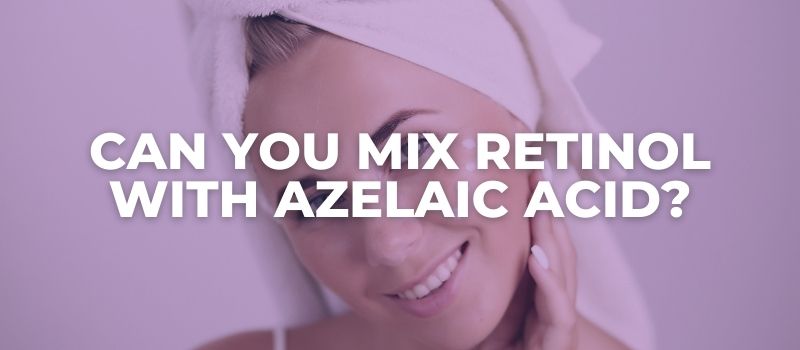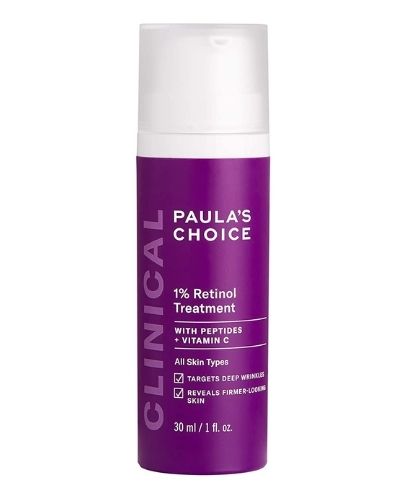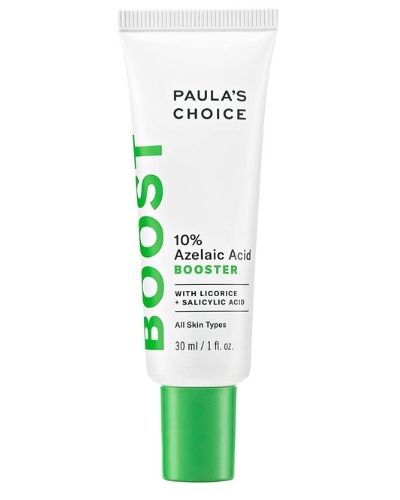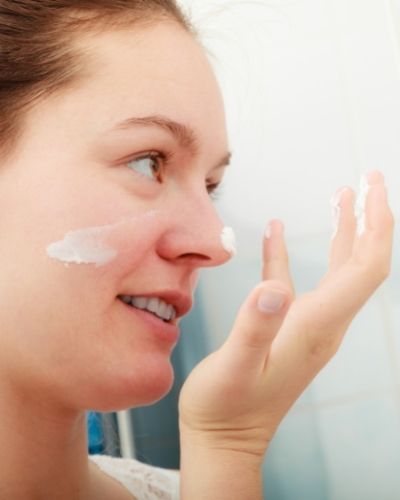Retinol and azelaic acid is an amazing combination of actives you can mix together to improve various skin concerns, including acne, clogged pores, discoloration, bumpy texture, and sun damage.
And while you can use retinol and azelaic acid together, even in the same routine, you still need to be aware potential side effects may occur.
Therefore, in this article, we will talk about the benefits and risks of using retinol and azelaic acid together as well as how to properly combine these two actives for best results and no unwanted reactions.

How Does Retinol Work?

Retinol is a component that belongs to the family of retinoids, which are vitamin A derivatives.
Retinol doesn’t remove dead skin cells from the surface of the skin like exfoliating acids do; but instead, the small molecules encourage rapid cellular renewal from the deeper layers of the skin.
The rapid cellular turnover will inevitably cause the dead skin cells on the surface of the skin to shed faster, which is why it can be said that retinol has an exfoliating-like action, but it’s a little bit different than regular exfoliation.
This action will rapidly clear out and decongest clogged pores and shed superficial hyperpigmentation until the skin tone is completely evened out and uniform.
Other than that, retinol can also neutralize free radicals and boost the production of elastin and collagen, which are the proteins that make the skin elastic and bouncy.
An increase in collagen and elastin production creates a “plumping” effect, which reduces the appearance of fine lines, wrinkles, and enlarged pores.
Finally, retinol has also been proven to balance your skin hydration levels.
Some benefits of using retinol include:
- decongested pores
- getting rid of acne
- improved wrinkles and fine lines
- brightening of hyperpigmented spots
- evening out uneven skin tone and texture
- getting rid of sun damage
- improving skin hydration
RELATED: Can You Mix Niacinamide With Retinol?
How Does Azelaic Acid Work?

Azelaic Acid is an ingredient that wasn’t well known in the skincare industry until some time ago. However, research has shown this ingredient can have a significant positive impact on the skin and certain skin concerns.
Azelaic acid can diminish the appearance of skin blemishes, help fade post-acne redness, pigmentation, and other discoloration, refine the skin’s surface, and reveal a brighter and more even complexion, among other actions.
The reason why it suddenly became loved and respected by everyone is azelaic acid is not an irritating ingredient and is fairly tolerable by all skin types, including sensitive and compromised skins.
It’s also one of the best ingredients for people who are dealing with rosacea as it helps relieve some of the symptoms such as pustules and excessive redness while not irritating the skin, like some stronger actives such as exfoliating acids.
Azelaic acid isn’t an AHA or BHA, but it is a distant relative to them, and although it has some mild exfoliating properties, it doesn’t really work the same way as azelaic acid is so-called dicarboxylic acid.
Azelaic acid can be naturally found in wheat, rye, and barley, but it can also be synthetically made in a lab, which is the case when it comes to being used in skincare products due to its effectiveness and stability.
Some benefits of using azelaic acid include:
- decreased inflammation
- decreased or healed acne (depending on the severity)
- decongested pores
- improved redness
- brightening of hyperpigmented spots
- evening out uneven skin tone and texture
Benefits of Using Retinol With Azelaic Acid
The benefits of using retinol with azelaic acid are many.
Both ingredients can help unclog the pores, which will allow sebum to flow freely to the surface of the skin instead of staying stuck inside and serving as food for the acne bacteria.
This means using retinol with azelaic acid can dramatically minimize breakouts and even completely get rid of acne over time and with the right supporting products in a complete skincare routine.
Besides, both retinol and azelaic acid can improve superficial hyperpigmentation and redness, particularly the stubborn, post-inflammatory redness that remains on lighter skins long after a pimple has healed.
Retinol and azelaic acid can also even out skin texture and improve uneven areas such as pitted scarring left from previous acne breakouts.
Retinol and azelaic acid can also get rid of sun damage that manifests on the skin in the form of darker spots, usually on the temples, cheeks, and upper lip.
Lastly, due to the anti-aging properties of retinol and smoothing properties of azelaic acid, this combo can also improve wrinkles and fine lines and leave you with a healthier, more uniform complexion.
Risks of Using Retinol With Azelaic Acid

As with any other active, the risk of potential irritation is present when it comes to using retinol with azelaic acid.
This mostly depends on the strength of both products.
For example, the risk of irritation or any other side effects such as peeling and dryness would be much smaller if you are using gentle, over-the-counter retinol and up to 10% azelaic acid, which is the highest strength in over-the-counter products.
However, if you are already using a prescription retinoid such as tretinoin or even adapalene and combining it with 20% azelaic acid (also a prescription medication), the risk of irritation, dryness, and peeling is much higher.
Which is why you have to be careful with these actives unless they are prescribed by a doctor, and your dermatologist also monitors your progress.
Don’t use strong percentages of both actives on your own, as doing this will only increase your chances of irritation and discomfort, but it can also push your skin into dermatitis or even rosacea territory, two conditions that are sadly permanent and very annoying to deal with.
If you want to treat certain skin concerns with these two actives on your own, I’d suggest you start with mild retinol such as SkinCeuticals Retinol 0.3 or Alastin Renewal Retinol 0.25, and Paula’s Choice 10% Azelaic Acid or Typology Mattifying Serum 10% Azelaic Acid, if your skin is on the oilier side.

My name is Simone and I am a certified skin specialist. I created this website to teach my readers how to take great care of their skin and I also like to occasionally share my honest opinions on skincare products I’ve tried. You can learn more about me here.
